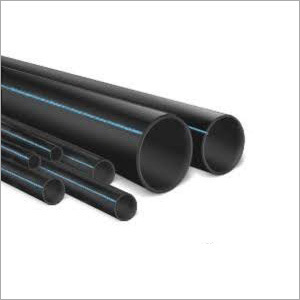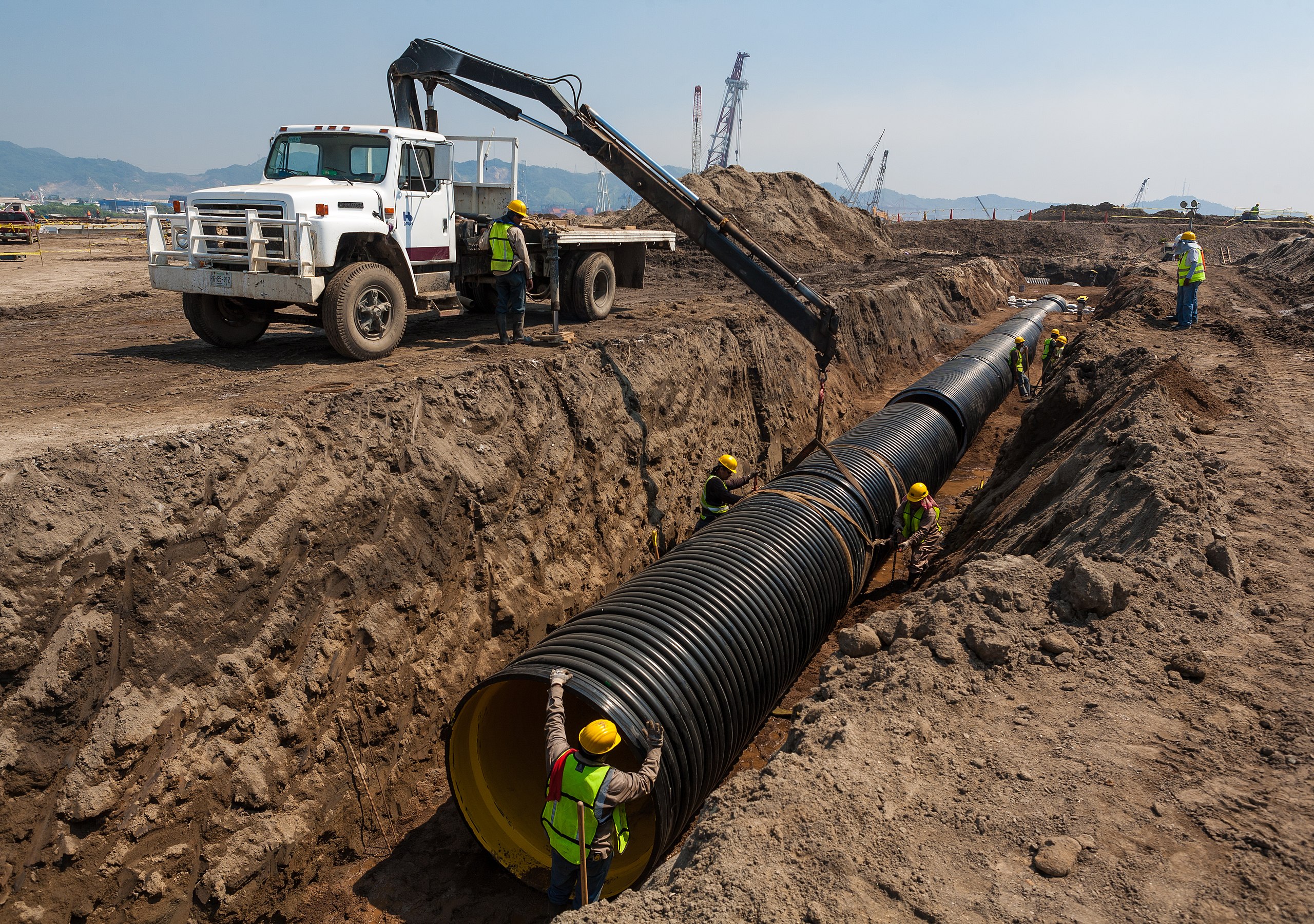Where to Source Midland TX HDPE Pipe Fittings in Stock for Urgent Orders
Explore the Production Process Behind High-Quality HDPE Pipeline and Its Applications
The production procedure of high-grade HDPE pipes is detailed and methodical. It starts with the selection of raw materials that boost efficiency. Following this, ethylene undergoes polymerization to develop resin, which is after that formed via extrusion. Quality control is critical, making sure that the end product fulfills rigid standards. The trip of HDPE pipes does not end with manufacturing. Their applications throughout numerous industries reveal a broader value worth taking a look at.
Understanding HDPE: Properties and Advantages

High-density polyethylene (HDPE) is a flexible thermoplastic understood for its toughness and resistance to numerous ecological elements. This material shows outstanding tensile strength, making it appropriate for requiring applications. Its low-density framework adds to a lightweight item, helping with simplicity of taking care of and installment. HDPE likewise showcases remarkable resistance to chemicals, which reduces destruction when revealed to harsh substances.
The product's low wetness absorption further enhances its long life, making it ideal for usage in pipelines and tank. In addition, HDPE is resistant to ultraviolet (UV) radiation, ensuring that items keep their stability even when exposed to sunshine. Its versatility enables for the production of detailed forms without jeopardizing stamina. The environment-friendly nature of HDPE, usually obtained from recycled products, contributes to its charm, advertising sustainable practices in manufacturing. On the whole, these properties and benefits make HDPE a favored option for various industrial and consumer applications.
Basic Material Option for HDPE Manufacturing
The option of basic materials for HDPE manufacturing is necessary to confirm the end product satisfies the preferred specs and top quality criteria. High-density polyethylene (HDPE) is mostly generated from polymerized ethylene, acquired from nonrenewable fuel sources such as natural gas or petroleum. The high quality of these feedstocks greatly influences the mechanical and thermal buildings of the final HDPE.
Additives also play a significant role in boosting HDPE's efficiency, including antioxidants, UV stabilizers, and colorants, which improve sturdiness and resistance to ecological variables. The option procedure have to think about not only the chemical structure of the raw products yet likewise their handling attributes to guarantee efficient manufacturing.
The sourcing of raw products must focus on sustainability and compliance with environmental regulations, as liable methods are necessary in today's market. Eventually, careful raw product selection lays the foundation for creating top notch HDPE pipes appropriate for diverse applications.
The Extrusion Process: Forming HDPE Pipe
The extrusion procedure plays an important duty in shaping HDPE pipes, starting with precise product preparation methods that guarantee optimal circulation and consistency. Just as vital is the layout of the die, which straight influences the final dimensions and surface area high quality of the pipe. With each other, these elements add greatly to the efficiency and top quality of HDPE pipeline production.
Material Prep Work Methods
Efficient production of HDPE pipes begins with precise product preparation methods, specifically the extrusion procedure. Throughout this stage, high-density polyethylene resin is very first dried out to get rid of wetness, making certain ideal circulation attributes. The resin is after that fed into the extruder, where it undergoes home heating and melting, changing right into a thick state. This home heating process is very carefully managed to maintain the product's integrity and efficiency. The molten HDPE is compelled via a die, shaping it into a constant pipeline kind. Appropriate temperature management during extrusion is essential, as it straight impacts the product's homes and perforated drain pipe with sock the end product quality. As soon as formed, the HDPE pipeline is cooled down and reduced to specified lengths, ready for succeeding processing and applications.
Die Design Importance
Accuracy in die style plays a crucial duty in the extrusion procedure of HDPE pipelines. The die acts as the last shaping device, directly influencing the pipe's dimensions, wall thickness, and surface area finish. A properly designed die guarantees consistent material flow, minimizing problems such as irregularities and weak spots. The geometry of the die should be enhanced to accommodate the particular buildings of HDPE, including its viscosity and thermal actions during extrusion. Furthermore, the cooling price of the product as it travels through the die can significantly impact the pipeline's architectural integrity. Investing in sophisticated die innovation is crucial for producers aiming to generate high-quality HDPE pipes that fulfill sector requirements and consumer expectations.
Quality Assurance Actions in HDPE Production
Various variables affect the high quality of HDPE pipe production, efficient high quality control measures are important to ensure uniformity and reliability in the final item (custom hdpe pipe manufacturing Midland TX). Key high quality control practices consist of rigorous product inspection, validating that the raw polyethylene satisfies recognized criteria for pureness and thickness. During the extrusion process, criteria such as temperature, pressure, and cooling time are closely monitored to preserve dimensional precision and architectural stability
Furthermore, post-production screening is crucial; producers typically perform hydrostatic tests to examine the pipeline's toughness and resistance to pressure. Visual evaluations for surface problems further enhance quality control. Qualification from pertinent criteria organizations, like ASTM or ISO, gives an extra layer of reputation. By executing these thorough quality assurance procedures, makers can minimize flaws, boost efficiency, and ensure that the HDPE pipelines meet the particular needs of numerous applications, inevitably bring about customer complete satisfaction and depend on in the item.
Applications of HDPE Pipe Across Industries
HDPE pipelines are made use of throughout numerous fields due to their resilience and flexibility. In water distribution systems, they assure reliable distribution, while in wastewater monitoring, they give dependable services for waste transportation. Additionally, farming irrigation networks take advantage of HDPE's resistance to corrosion and versatility, making it an ideal choice for modern-day farming techniques.

Water Circulation Equipments
A substantial number of sectors count on high-density polyethylene (HDPE) pipelines for effective water distribution systems. Recognized for their longevity and resistance to corrosion, HDPE pipes are commonly utilized in municipal supply of water networks, farming irrigation, and industrial applications. Their lightweight nature assists in very easy handling and setup, lowering labor costs and time. In addition, HDPE pipes can suit numerous stress degrees, making them appropriate for both reduced and high-pressure systems. Pipe Manufacturing Midland TX. The adaptability of the product enables seamless combination into existing framework, minimizing the requirement for comprehensive excavation. HDPE's resistance to chemical seeping warranties that the water supplied continues to be risk-free and clean, making it a suitable selection for keeping the high quality of safe and clean water across different markets.
Wastewater Administration Solutions
Efficient water distribution systems additionally lead the way for cutting-edge wastewater management services, where high-density polyethylene (HDPE) pipelines play a substantial role. Popular for their durability and resistance to corrosion, HDPE pipelines are perfect for delivering wastewater in different setups. Their versatility permits simple installment in intricate environments, minimizing the demand for considerable excavation. Additionally, HDPE's smooth indoor surface area reduces friction, boosting circulation prices and effectiveness. These pipes are also resistant to chemical leaching, ensuring that impurities do not jeopardize the surrounding setting. Industries, districts, and treatment centers increasingly rely upon HDPE pipes for their integrity and long life, making them a recommended selection for modern-day wastewater management systems. This versatility emphasizes the critical significance of HDPE pipelines across countless applications.
Agricultural Watering Networks
Agricultural watering networks profit greatly from making use of high-density polyethylene (HDPE) pipelines, which give effective and reputable water distribution to plants. HDPE pipes are lightweight, making them very easy to carry and mount, while their versatility enables for different configurations in diverse surfaces. These pipelines demonstrate superb resistance to corrosion, chemicals, and UV radiation, making sure longevity in extreme agricultural environments. Additionally, their smooth interior surface lessens rubbing loss, optimizing water circulation and reducing power costs related to pumping. The long life of HDPE pipelines, usually exceeding half a century, adds to lower upkeep and replacement expenditures. Farmers increasingly depend on HDPE pipelines to improve watering effectiveness and promote lasting agricultural practices, inevitably leading to boosted plant returns and resource preservation.

Future Patterns in HDPE Pipe Modern Technology
As the need for lasting and effective facilities grows, improvements in HDPE pipeline innovation are poised to change different markets. Emerging fads consist of the assimilation of smart innovations, such as sensing check that units and IoT capacities, which promote real-time tracking of pipeline problems, reducing maintenance costs and preventing leaks. Additionally, the development of innovative production techniques, such as 3D printing, is allowing the manufacturing of complex, personalized pipe designs that deal with details task requirements.
Moreover, the concentrate on recycling and round economic situation practices is driving the development of HDPE pipes made from recycled materials, boosting sustainability. Boosted jointing techniques, such as electro-fusion and mechanical fittings, are likewise enhancing setup effectiveness and integrity. Ultimately, the growing emphasis on ecological regulations is pushing suppliers to adopt greener manufacturing processes, ensuring that HDPE pipelines not only meet market criteria but additionally promote navigate to these guys a more sustainable future for infrastructure development.
Frequently Asked Inquiries
Just How Does HDPE Contrast to Various Other Plastic Products?
HDPE outshines numerous other plastic products regarding longevity, chemical resistance, and versatility. Its reduced density and high tensile stamina make it excellent for various applications, usually going beyond choices in both performance and longevity.
What Are the Environmental Effects of HDPE Production?
The environmental impacts of HDPE manufacturing consist of greenhouse gas exhausts, energy intake, and prospective contamination from manufacturing processes. Furthermore, improper disposal can cause soil and water contamination, raising worries concerning lasting ecological results.
Can HDPE Water Lines Be Reused?
Yes, HDPE pipelines can be recycled. Lots of facilities approve utilized HDPE for handling, transforming it into brand-new products. This reusing adds to sustainability initiatives, lowering plastic waste while preserving resources and power in the manufacturing cycle.
What Is the Life Expectancy of HDPE Pipeline?

How Do Temperature Variants Influence HDPE Pipeline Efficiency?
Temperature variations significantly affect HDPE pipeline performance, impacting adaptability and toughness. Heats can result in softening, while low temperatures may cause brittleness, eventually affecting the pipe's toughness and viability for numerous applications in varied environments.